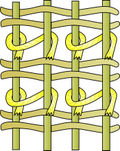Pileis the raised surface ornapof afabric,consisting of upright loops or strands ofyarn.[1]Examples of piletextilesarecarpets,corduroy,velvet,plush,and Turkish towels (terrycloth).[2]The word is derived from Latinpilusfor "hair".[3]
Length and density
editThe surface and the yarn in these fabrics are also called "pile". In particular "pile length" or "pile depth" refer to the length of the yarn strands (half-length of the loops). Pile length affects and is affected byknot density:"The greater the knot density, the thinner the weft and warp yarns and the more weakly are they twisted; the smaller the density, the coarser are the foundation yarns."[4]Designs and motifs are also affected by and affect pile depth: "A carpet design with a high knot density is better adapted to intricate and curvilinear designs, which of necessity must have a shorter pile length to avoid looking blurry. A carpet with a lesser knot density is better adapted to bold, geometric designs and can utilize a long pile for softer, more reflective surface that appeals to the sense of touch."[5]
Types
edit- Loop
- Uncut
- Cut
- Knotted
- Tufted
- Woven
- Cord
- Twist
See also
editReferences
edit- ^"Pile."The Oxford English Dictionary.2nd ed. 1989.
- ^"pile",Dictionary.comUnabridged (v 1.1). Random House, Inc. Retrieved 10 September 2007.
- ^"Pile,"Online Etymology Dictionary. Douglas Harper, Historian. retrieved fromdictionary.com10 September 2007.
- ^Tzareva, Elena (1984).Rugs & carpets from Central Asia: the Russian collections,p.12-3. Penguin.ISBN9780140063691.
- ^Denny, Walter B. (2014).How to Read Islamic Carpets,p.43 & 61. Metropolitan Museum of Art.ISBN9780300208092.

